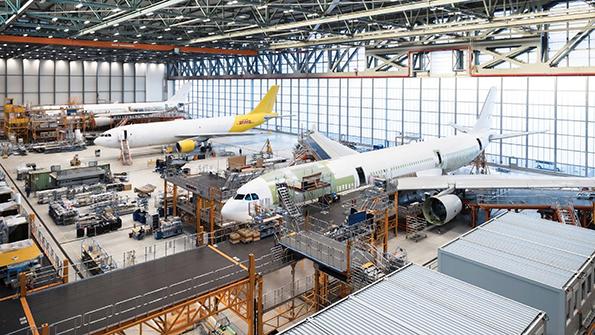
EFW has seen a growing demand for its Airbus A320 and A330 passenger-to-freighter conversions.
OEMs and conversion specialists are rushing to fill the seemingly ever-growing requirement for new freighters as e-commerce booms and cargo operators seek to renew their fleets.
While the pandemic created an uptick in demand for freighter capacity as bellyhold cargo capacity shrank, the seemingly unstoppable growth of e-commerce is maintaining what was already a growing sector of the marketplace.
The phenomenon is causing airlines and lessors to look at new purposes for passenger aircraft reaching that tricky mid-life period when maintenance costs start to ratchet upward as second C-checks loom.
The answer for many operators is to convert those aircraft into freighters. With their lower utilization rates, a freighter that has spent the first 12-15 years of its life ferrying passengers can easily have a second career of up to 20 years hauling cargo.
Those changes are reflected by Boeing, for example, which in 2021 clocked up more than 100 orders for its two active freighter conversion programs, the 737-800BCF and 767-300BCF.
Some idea of the growth of the conversion business comes from the fact that, as well as existing 737-800BCF conversion lines in Asia, Europe and the Americas, more are planned in Canada, Costa Rica and the UK. Existing conversion sites for the 767-300BCF in China and Singapore are also scheduled to be increased with new locations.
As well as the growth in cargo traffic, OEMs and conversion specialists see a growing amount of their future business coming from fleet replacements.
Traditionally, freighters have been well past their prime, but even the most long-lived or well-maintained examples eventually shuffle off to the scrap heap.
EFW, for example, sees the Airbus A321 as the natural replacement for aging Boeing 757s.
“The 757 has been one of the most successful freighters, but those will have to be replaced,” EFW’s VP sales and marketing, Wolfgang Schmid, said.
EFW converts the A320 and A330 families to freighters and Schmid said the A330 is well-positioned to replace not only the earlier A300-600 but also the Boeing 767 and McDonnell Douglas MD-11.
The A330-300 P2F, which is readily available secondhand, “is even a competitor for the 777-200, while the A320 is on the same level as the 737-800,” he said.
EFW plans to convert at least 30 of each family by 2024-25, Schmid said.
The company has facilities in Shanghai and Guangzhou, which have been affected by China’s COVID lockdowns, but will provide additional capacity when fully up and running now that the restrictions have been lifted. EFW also operates another A320 conversion plant in San Antonio, Texas, and an A330 line in Mobile, Alabama.
An additional plant is planned for China and an agreement was signed with Turkish Technic in 2022 for yet another conversion site in Turkey. All of which gives some idea of the perceived demand for new cargo capacity.
Is there a risk that capacity might outstrip future demand? Schmid does not believe so. With a large proportion of new freighters being required as replacements for aging aircraft, that business stream is solid, he said, “but we also see a very big portion for growth—and especially e-commerce demand will grow further.”
Small Freighters
Embraer also regards e-commerce as a major spur for the growth of the conversion market. The Brazilian OEM plans to convert E190/195 E1 series regional jets, starting in 2024.
Embraer predicts a market for 700 smaller freighters over the next 20 years, of which it hopes to win 20% to 30% of the market. Around 40% of this total will be replacement aircraft, the remaining 60% will be for growth in the market.
Even before the pandemic, the market was increasing exponentially, Embraer strategic marketing director Daniel Gachardo Gomez said.
“Some big operators, like FedEx, were already looking to have a smaller plane in terms of payload, to reach more destinations. I see it replacing mainly 737-300s, with which it has a very similar capacity and payload,” he said.
A smaller aircraft makes sense when trying to expand the dedicated cargo network into smaller airports, he said, especially as e-commerce purchasers increasingly expect to receive their goods the following day or even the same day they order them.
Also at the lower end of the size scale are freighter conversions from ATR and De Havilland Canada. ATR has gone from the conversion of five of its turboprops annually to approaching 15, and business development director Gilles Collaveri sees “strong and steady growth” in this market.
The E-commerce Boost
E-commerce is the main driver of this growth; the resulting need for greater internal volume means the ATR 72 is more favored as a freighter than the smaller ATR 42.
The ATR 72-500 is the model of choice at present.
“We’ll see the first -600 converted in the next few years; the oldest -600s today are 11-12 years old, so they’re getting close to conversion age,” Collaveri said.
A second factor behind demand for the company’s freighters is that they can get into small airports, bringing goods to remote communities, he said.
ATR is also well into the process of providing FedEx with its 30 new-build dedicated ATR 72-600 freighters.
Ironically, Collaveri said, when the original ATR was still on the drawing board 40 years ago, engineers visited FedEx founder Fred Smith, who bluntly declared that he would never buy the aircraft because the fuselage cross-section was too small and that ATR should add two inches to it, to make the aircraft capable of taking pallets. ATR’s designers did so.
“We owe Fred Smith a lot,” Collaveri said.
Also in the turboprop category, the 2022 Farnborough Air Show saw De Havilland Canada launch three cargo conversion solutions for its Dash 8-400, which it calls Quick Change (QC), Package Freighter (PF) and Freighter with Large Cargo Door (F-LCD) configurations. The QC will be able to switch between all-cargo and all-passenger layouts, while the PF will allow bulk loading of cargo, such as e-commerce packages, with four additional access doors. The F-LCD will have a cargo loading system to facilitate the transport of up to eight LD3 containers.
Business on “the far side of the airport” seems set to continue to grow for some time yet.
